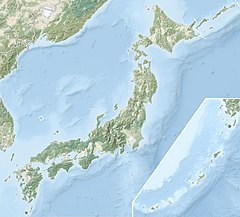Tsunoshima Lighthouse

Tsunoshima Lighthouse
|
|
| Location |
Tsunoshima Shimonoseki, Yamaguchi Japan |
|---|---|
| Coordinates | 34°21′08.9″N 130°50′27.7″E / 34.352472°N 130.841028°ECoordinates: 34°21′08.9″N 130°50′27.7″E / 34.352472°N 130.841028°E |
| Year first constructed | March 1, 1876 |
| Construction | granite tower |
| Tower shape | cylindrical tower with balcony and lantern |
| Markings / pattern | unpainted tower, white lantern |
| Height | 29.62 metres (97.2 ft) |
| Focal height | 44.66 metres (146.5 ft) |
| Original lens | First order Fresnel |
| Intensity | 670,000 Candela 1,400,00 cd |
| Range | 18.5 nautical miles (34.3 km; 21.3 mi) |
| Characteristic | Fl. W 5s |
| Admiralty number | M7397 |
| NGA number | 1568 |
| ARLHS number | JPN-693 |
| Japan number | JCG-0715 |
Tsunoshima Lighthouse (角島灯台 tsunoshima tōdai?) is a lighthouse on the island of Tsunoshima in the city of Shimonoseki, Yamaguchi Prefecture, Japan. It is notable as being one of only six lighthouses in Japan which had a first order Fresnel lens, the most powerful type of Fresnel lens.
The lighthouse was first lit on March 1, 1876, in the Meiji period of Japan. It was one of the lighthouses designed by Richard Henry Brunton, who was hired by the government of Japan to help construct lighthouses to make coastal waters safe for foreign ships to approach, after Japan opened up to the West.
The lighthouse is open to the public. It is accessible by car, bicycle, or public transportation; specifically by bus from Kottoi Station.
...
Wikipedia

